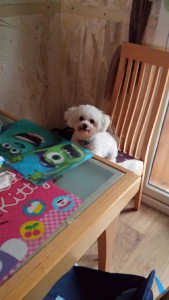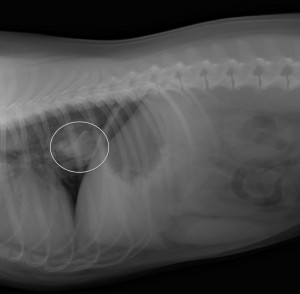Betty’s facelift
Meet Betty the lovely Bassett Hound. Betty is 3 years of age and as you can see from the photog..
+ Read moreFor most dogs the idea of chewing on a bone is heaven. However, for some, their excitement to devour the bone can sometimes mean that they swallow large chunks of spiky bone and so the transit from the throat to the stomach is far from straight forward.
The oesophagus is the muscular tube that propels food along to the stomach in a matter of seconds, but a large chunk of spiky bone can get completely lodged either in the throat, over the region of the heart or in front of the entry into the stomach.
Oscar had been enjoying himself running around the woodland when he came across a tasty bit of bone in a bush. Wanting to make sure only he was going to eat the bone, he gave it a few cursory crunches, gulped and swallowed before his owner could retrieve his prize. That night Oscar was a little subdued, but as the days passed, Oscar became depressed, wanting to eat but then not eating and even started to bring up water.
Oscar was taken to the Animal Trust in Failsworth, Manchester where an xray diagnosed that a section of bone was lodged in his oesophagus. There were 3 options for Oscar, could we use a special customized scope and forceps provided by the Visiting Vet Specialist to nibble away part of the bone and then secure the remainder and carefully remove the remainder out of the mouth? Or if this was not possible, using the oesophascope again, could the bone be pushed into the stomach for the stomach acid to dissolve the bone? Or thirdly, if both scoping attempts were unsuccessful, then the lodged bone could be removed by surgically opening the chest – a thoracotomy surgery.
Oscar was a lucky boy as we were able to use the special oesophascope to retrieve the oesophageal foreign body – the bone. However, the story does not end there. Most dogs that get bones stuck have pressure ulceration where the bone has been lodged in the oesophagus and reflux oesophagitis (heart burn). Oscar bone had been lodged for a number of days, so it was very important that Oscar received medications to soothe the ulceration and reduce gastric acid. In very severe cases, it can sometimes be necessary to place a feeding tube into the stomach to use for a few weeks to bypass the extremely sore areas in the oesophagus. In pets where there has been severe ulceration and inflammation, excessive scar tissue can form resulting in a stricture (narrow, tight band). If this happens the pets will regurgitate their food and additional measures to stretch the stricture have to be considered.
We are happy to report that Oscar is doing well and has not lost his love of a tasty snack!

